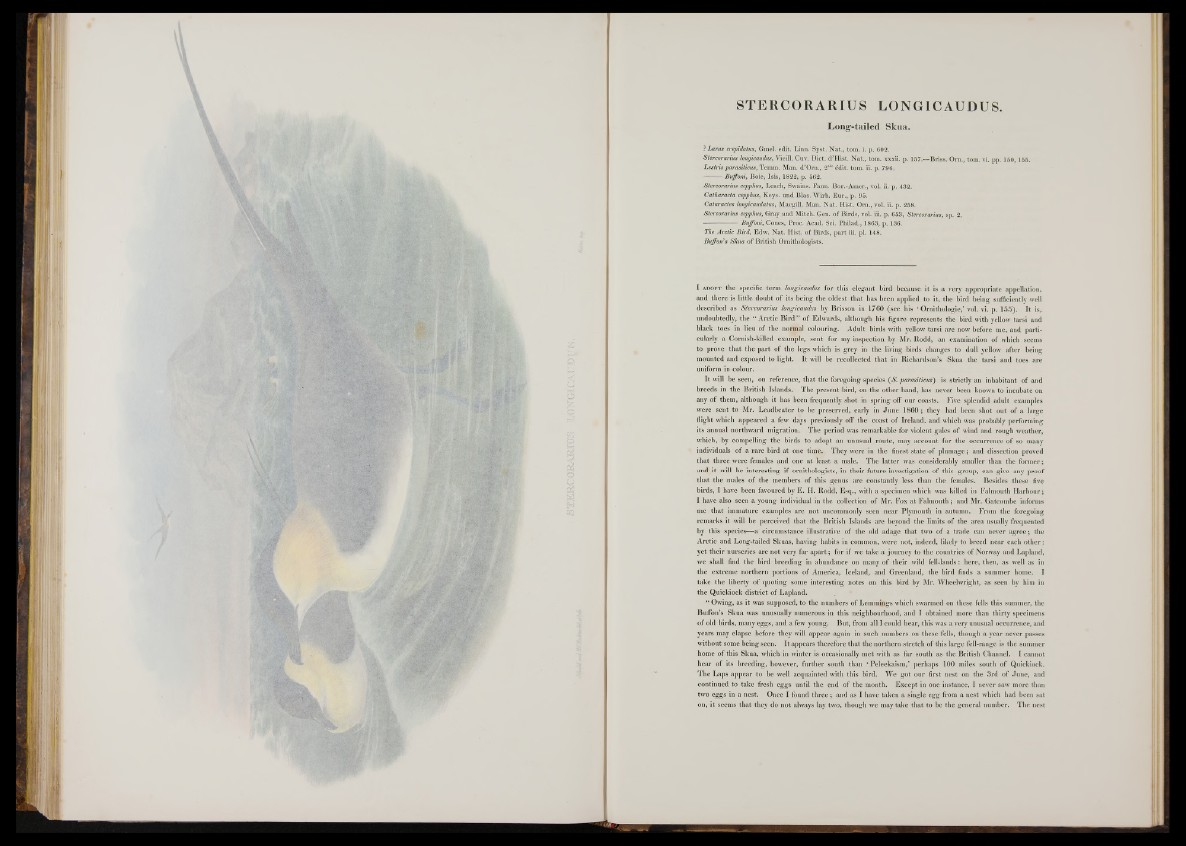
Long-tailed Skua.
? Larus crepidatus, Gmel. edit. Linn. Syst. Nat., tom. i. p. 602.
Stercorarius longicaudus, Vieill. Cuv. Diet. d’Hist. Nat., tom. xxxii. p. 167.—Briss. Ora.., tom. vi. pp. 150, 155.
Lestris parasiticus, Temm. Man. d’Orn., 2nd* édit. tom. ii. p. 796.
Buffoni, Boie, Isis, 1822, p. 562.
Stercorarius cepphus, Leach, Swains. Faun. Bor.-Amer., vol. ii. p. 432.
Catharacta cepphus, Keys, und Bias. Wirb. Eur., p. 95.
Cataractes longicaudatus, Macgill. Man. Nat. Hist. Ora., vol. ii. p. 258.
Stercorarius cepphus, Gray and Mitch. Gen. of Birds, vol. iii. p. 653, Stercorarius, sp. 2.
--------------- Buffoni, Coues, Proc. Acad. Sci. Philad., 1863, p. 136.
The Arctic Bird, Edw. Nat. Hist, of Birds, part iii. pi. 148.
Buffon’s Skua of British Ornithologists.
I a d o p t the specific term longicaudus for this elegant bird because it is a very appropriate appellation,
and there is little doubt o f its being the oldest that has been applied to it, the bird being sufficiently well
described as Stercorarius longicaudus by Brisson in 1760 (see his ‘ Ornithologie,’ vol. vi. p. 155). It is,
undoubtedly, the “ Arctic Bird” of Edwards, although his figure represents the bird with yellow tarsi and
black toes in lieu o f the normal colouring. Adult birds with yellow tarsi are now before me, and particularly
a Cornish-killed example, sent for my inspection by Mr. Rodd, an examination of which seems
to prove that the part o f the legs which is grey in the living birds changes to dull yellow after being
mounted and exposed to light. It will be recollected that in Richardson’s Skua the tarsi and toes are
uniform in colour.
It will be seen, on reference, that the foregoing species (S . parasiticus') is strictly an inhabitant o f and
breeds in the British Islands. The present bird, on the other hand, has never been known to incubate on
any of them, although it has been frequently shot in spring off our coasts. Five splendid adult examples
were sent to Mr. Leadbeater to be preserved, early in June 1860; they had been shot out of a large
flight which appeared a few days previously off the coast of Ireland, and which was probably performing
its annual northward migration. The period was remarkable for violent gales of wind and rough weather,
which, by compelling the birds to adopt an unusual route, may account for the occurrence of so many
individuals o f a rare bird at one time. They were in the finest state of plumage; and dissection proved
that three were females and one at least a male. The latter was considerably smaller than the former;
and it will be interesting if ornithologists, in their future investigation o f this group, can give any proof
that the males o f the members of this genus are constantly less than the females. Besides these five
birds, I have been favoured by E. H. Rodd, Esq., with a specimen which was killed in Falmouth Harbour;
I have also seen a young individual in the collection o f Mr. Fox at Falmouth; and Mr. Gatcombe informs
me that immature examples are not uncommonly seen near Plymouth in autumn. From the foregoing
remarks it will be perceived that the British Islands are beyond the limits o f the area usually frequented
by this species—a' circumstance illustrative o f the old adage that two o f a trade can never agree; the
Arctic and Long-tailed Skuas, having habits in common, were not, indeed, likely to breed near each other:
yet their nurseries are not very far apart; for if we take a journey to the countries of Norway and Lapland,
we shall find the bird breeding in abundance on many o f their wild fell-lands: here, then, as well as in
the extreme northern portions o f America, Iceland, and Greenland, the bird finds a summer home. I
take the liberty o f quoting some interesting notes on this bird by Mr. Wheelwright, as seen by him in
the Quickiock district o f Lapland.
“ Owing, as it was supposed, to the numbers o f Lemmings which swarmed on these fells this summer, the
Buffon’s Skua was unusually numerous in this neighbourhood, and I obtained more than thirty specimens
o f old birds, many eggs, and a few young. But, from all I could hear, this was a very unusual occurrence, and
years may elapse before they will appear again in such numbers on these fells, though a year never passes
without some being seen. It appears therefore that the northern stretch o f this large fell-range is the summer
home of this Skua, which in winter is occasionally met with as far south as the British Channel. I cannot
hear o f its breeding, however, further south than ‘ Peleekaism,’ perhaps 100 miles south of Quickiock.
The Laps appear to be well acquainted with this bird. We got our first nest on the 3rd o f June, and
continued to take fresh eggs until the end o f the month. Except in one instance, I never saw more than
two eggs in a nest. Once I found three ; and as I have taken a single egg from a nest which had been sat
on, it seems that they do not always lay two, though we may take that to be the general number. The nest